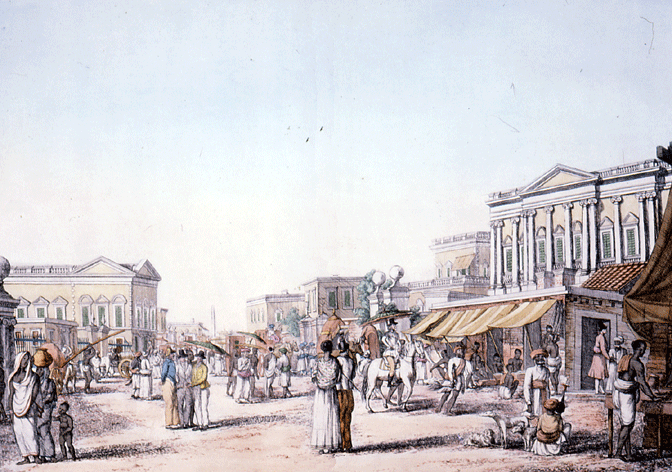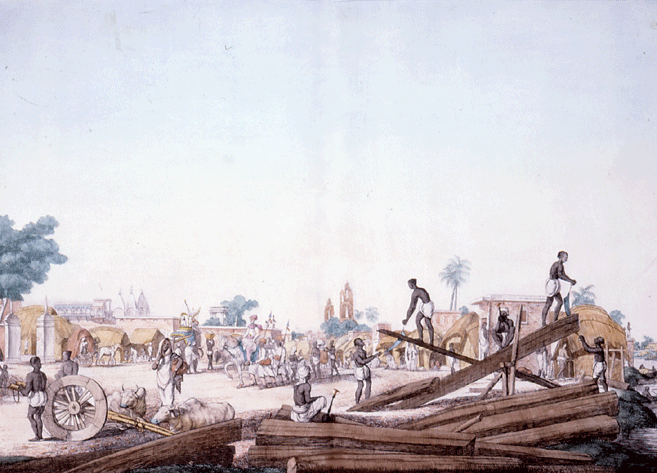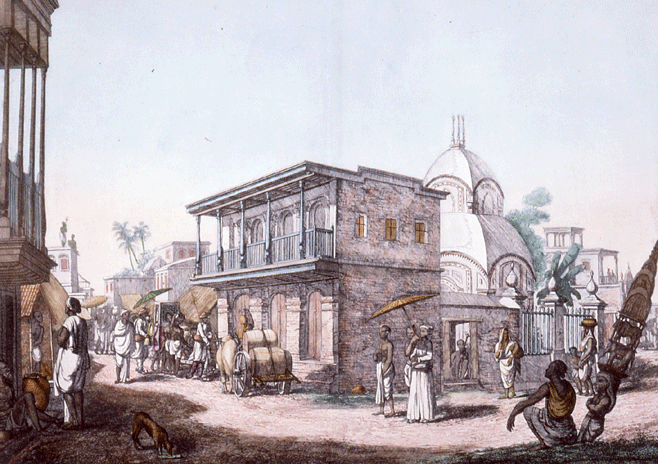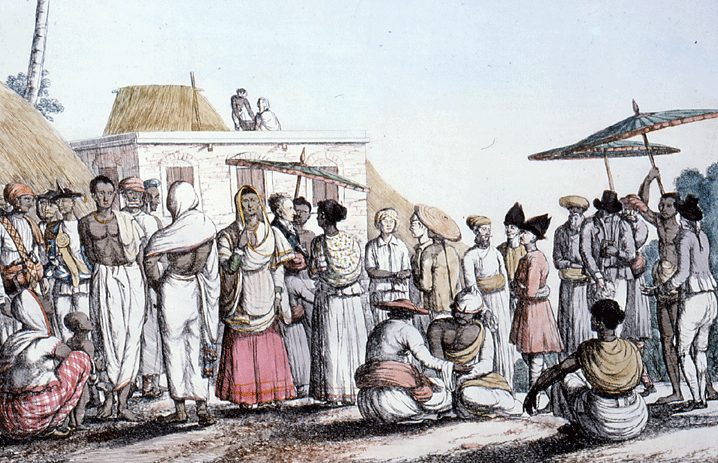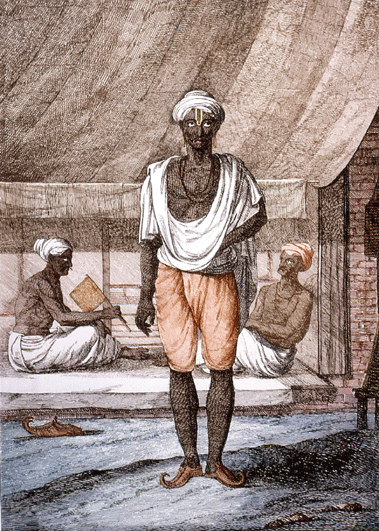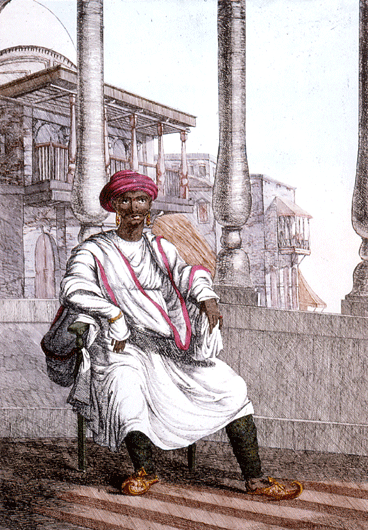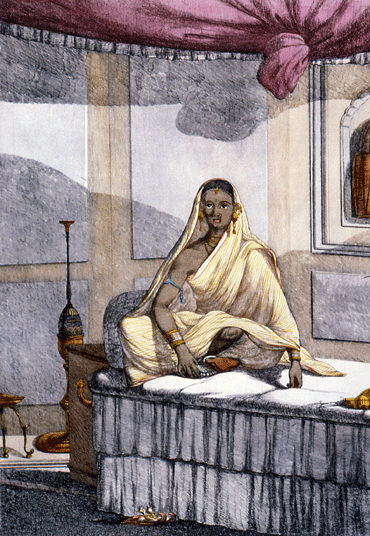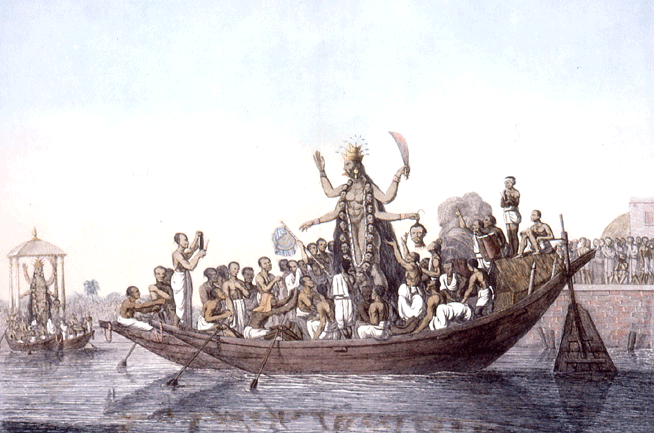"A Portrait of Black Town: Balthazard Solvyns in Calcutta, 1791-1804." In Changing Visions, Lasting Images: Calcutta Through 300 Years, edited by Pratapaditya Pal, 31-46. Bombay: Marg, 1990.
NOTE TO READER: This article was written as I was beginning the Solvyns project. In subsequent research, I found that Solvyns departed India in 1803, not 1804, and that he married only after his return to Europe in 1804. R.L.H. June 2001.
A Portrait of Black Town
Baltazard Solvyns in Calcutta
1791-1804
Robert L. Hardgrave, Jr.
Among the European artists who have depicted Calcutta, Baltazard Solvyns is one of the few to portray Indians, mostly Hindus, in their life and work. Born in Antwerp in 1760, Solvyns had pursued a career principally as a marine painter until political unrest in Europe and his own insecure position led him to seek his fortune in India. In the late eighteenth century India had attracted a number of British artists who found a ready market for their works among the Europeans of Calcutta and Madras and in the courts of the Indian princes. William Hodges and later Thomas and William Daniell sold landscapes, but the most handsome profits were to be made in portraiture, and here such painters as Tilly Kettle, Thomas Hickey, and John Zoffany enjoyed the patronage of both nabobs and nawabs.1
Solvyns was adept at neither landscape nor portraiture, and upon his arrival in Calcutta in 1791, he became something of a journeyman artist. He provided decoration for celebrations and balls, cleaned and restored paintings, and offered instruction in oils, water-colour, and chalk. The decoration of coaches and palanquins apparently provided Solvyns his steadiest income, but hardly the success and sense of accomplishment he clearly sought. In 1794, with the encouragement of Sir William Jones, Solvyns announced his plan to prepare "250 coloured etchings descriptive of the manners, customs, character, dress, and religious customs of the Hindoos."
With a sufficient number of subscribers, Solvyns set out to record the life of the native quarter of Calcutta, or "Black Town," as it was then called. He approached his task as an ethnographer, drawing his subjects from life and with more concern for accuracy than aesthetics. The collection, published in Calcutta in 1799, was divided into twelve parts. The first section, with sixty-six prints, depicts "the Hindoo Castes with their respective professions." Following sections portray servants, costumes, musical instruments,2 means of transportation (carts, palanquins, and boats), modes of smoking, fakirs, and festivals.
The project proved a financial failure. The etchings, by contemporary European standards, were rather crudely done; the forms and settings were monotonous; and the colours were of sombre hue. They were not, in short, in keeping with the vogue for the picturesque. But the subjects were themselves compelling, and the London publisher Edward Orme brought out a pirated edition of sixty prints "after Solvyns," that were redrawn and coloured in warm pastels for appeal. The volume, Costumes of Hindoostan,3 through various editions, was highly successful, but Solvyns derived no gain and suffered, as he later wrote, "abuse. . . made of his name and of his works."4
In 1804, Solvyns left India for France, accompanied by an English woman of means whom he had married in Calcutta. Drawing upon his wife's resources, he prepared new etchings and produced a folio edition of two hundred and eighty-eight plates--Les Hindous, published in Paris between 1808 and 1812 in four elephantine volumes.5 In his introduction, Solvyns writes that while European scholars have done much "to dispel the darkness which enveloped the geography and history of India, . . . its inhabitants alone have not yet been observed nor represented with the accuracy which is necessary to make them perfectly known . . ." To rectify this situation, he offered to the public Les Hindous, "the result of a long and uninterrupted study of this celebrated nation."6
The Founding and Growth of Calcutta
By 1790, the year Solvyns set out from Europe and one hundred years after Job Charnock founded the settlement at Sutanuti, Calcutta was already a "city of palaces." Extending for about five kilometres along the Hooghly, the three villages of Sutanuti, Kolkata, and Govindapur, to which the Honourable Company had been granted rights as zamindar in 1698, had quickly merged, and the area of Calcutta, as it came to be called, had more than doubled. The population of the city in Solvyns' time was calculated to be as high as five hundred thousand, probably an overestimate, although the population fluctuated dramatically in the eighteenth century because of war, epidemics, and famine.7
At the time of the original settlement, Sutanuti was a small village inhabited largely by weavers, a principal factor in the selection of the site as a trading centre, but within a decade, the English had shifted southward to the adjoining village of Kolkata (Calcutta), where the old Fort William was constructed. The European town developed around the fort, where later the Customs House was built, and the area became the commercial and official centre of the city. After the Battle of Plassey in 1757, Govindapur, further down the river, became the site of the Maidan and the new Fort William. In the 1790s, Chowringhee was still considered "out of town," but affluent Europeans had begun to build "garden houses" in the area.
Of the European Buildings at Calcutta, Solvyns writes that the houses "are always at some distance from the other, and have a very respectable appearance. They have all grand peristyles of different orders: the doors and windows are large, and the rooms very lofty, on account of the extensive heat . . . The walls are painted white, paper or tapistry are never used; they are sometimes hung with prints or pictures, but these are destroyed in a short time. Chimnies are seldom seen, the apartments are generally on the first story, but the dining-room is frequently on the groundfloor. The roofs are always flat and accessible by a staircase . . . The walls are built of baked bricks, and the morter composed of lime and brickdust: this is covered first with a coat of sand and lime, and afterwards with powdered shells which give a dazzling white colour."(Solvyns, Les Hindous [Paris: Chez L'Auteur, 1811], vol. 111, sec. 12, plate 1). [See Fig. A.]
|
|
|
Fig. A. European Buildings at Calcutta. Solvyns, Les Hindous, vol. 111 (1811), sec. 12, plate 1.
48 x 34.5 cm.
|
Black Town
|
|
|
Fig. 1. The Black Town of Calcutta. Solvyns, Les Hindous, Vol. III (1811), sec. 9, plate 1.
48 x 34.5 cm.
|
Calcutta had from the early eighteenth century been divided into fairly distinct European and Native quarters. In his notes to the illustration The Black Town of Calcutta, Solvyns writes:
"Each nation at Calcutta has its particular quarter; so we have the English quarter, the Portuguese quarter, etc.... That which is inhabited by the natives, who, whether they are originally Hindoos or Mussulmans, differ from all the others by their complexion which is as dark as the Caffries,8 is called the Black Town.. No European is to be seen there, and the construction of the houses is entirely different from ours: one part of it is represented in this print. The road on which are seen men on horseback, on foot, and in palanquins, is that which leads to Chitpore. As there is a considerable carriage of wood here, on account of the magazines and different buildings, the general employment of the neighbourhood is sawing planks for which they use small curbed saws as in the print; and with these they do a great deal of work in the day, when they work on their own account: for they seem to undergo a total change as soon as they come under a master, and are as lazy as they were industrious."
In Hindoo Buildings [Fig. 2], Solvyns describes the character of Black Town:
"A view of Calcutta seemed best calculated to convey an idea of the architecture of the Hindoos. [T]his town, one of the largest and most magnificent of India, [is] every day increasing by the many sumptuous buildings erected especially in the residence of the English . . .In the vast population of this capital the mixture of different nations is more striking than in the other towns of Hindoostan. This drawing represents the quarter inhabited chiefly by Hindoos, called the Black Town; it is taken from the road leading to Chitpore, a place almost exclusively peopled by the natives of the country. My intention was to give, as far as it could be done in a single drawing, a general idea of the distinctive character of the Hindoo architecture. The first striking difference is the conical form of all their pagodas or mundars in this capital, amidst the spherical domes of the Musselman mosques... The private houses, both of the rich and poor, are generally surrounded at the first story by large covered balconies. Besides their use in keeping out the rays of the sun from the interior apartments, they serve as a place of repose to the indolent Hindoo, where he enjoys a cooler air and sleeps away the heat of the day, while his servants give a gentle motion to the air around him, with large fans called pankas [punkah].9 Here too he indulges in the phlegmatic pleasure of smoking the hooka and frequently receives his visits."
|
|
|
Fig. 2. Hindoo Buildings. Solvyns, Les Hindous, Vol. II (1810), Sec. 1 plate 1.
48.34.5 cm.
|
Central to the life of the Black Town was the bazaar, and the largest and most important was Burra Bazar. Solvyns does not tell us which Hindoo Bazar he depicts [Fig. 3].
|
|
|
Fig. 3. Hindoo Bazar. Solvyns, Les Hindous, Vol. III (1811), Sec. 11, plage 1. 48 x 34.5 cm.
|
"There are at present in Hindoostan few Bazars frequented exclusively by Hindoos: this which the print represents is of that number. These Markets are generally held near the house of some great man who lets out the spot and levies a tax upon the merchants who expose their goods to sale, under sheds or mats or in shops."
Peoples of Calcutta
Calcutta was a cosmopolitan city, with natives from all regions of India, Europeans from any number of countries, Armenians, and the ubiquitous Portuguese--the term broadly used to refer to Eurasians of Portuguese ancestry and often to native Roman Catholics. "To give the public an idea of the sight which an Indian town offers to a traveller,"Solvyns in Of the Nations Most Known in Hindoostan [Fig. 4.] brought together "all the different costumes which are there met with. In the foreground is a Hindoo with his wife, a man of upper Hindoostan, a Mussulman, a Mogul, 10 a Persian, an Arabian, a Mug, 11 a Chinese, a Malay, an Arminian and some Europeans, Englishman, Dutchman and others, as different nearly from each other in their appearance, as they are from the Hindoos."
|
|
|
Fig. 4. Of the Nations Most Known in Hindoostan. Solvyns, Les Hindous, Vol. III. (1811), sec. 12. plate 5.
5.24 x 34.5cm.
|
| Solvyns devoted much of his work to the portrayal of the various castes and occupations of the Hindus of Calcutta. The Tanti, or weaver caste, was among the most important, for it was the cloth trade that brought Calcutta its early wealth. The Setts and Bysacks, great trading families who contributed sigruficantly to the growth of Calcutta, belonged to this community.l2Solvyns depicts the Tantys [Fig. 5.] working at their loom. "Seated here upon mat with his houka or smoking piper, and his vase of water to quench his thirst and wash his hands and feet, the Tanty weaves with quiet indifference those cotton stuffs so highly valued in Europe." |
|
|
|
Fig. 5. Tantys. Solvyns, Les Hindous, Vol. I (1808), sec. 5, plate 2. 24 x 34.5 cm.
|
|
|
|
|
Fig. 6. Sonar-Bunnyas. Solvyns, Les Hindous, Vol. I, sec. 6, plate 2. 24 x 34.5 cm.
|
|
Calcutta was also a city of finance, and Hindu bankers and money-changers, of whom the Sounar-Bunnyas [Sonar Baniya, Suvarna Baniks, Fig. 6],played a major role in the supply of capital. "The money changers who are also called shroffs," Solvyns writes, "are at the same time bankers. They are good calculators, and lend upon pledges at a very high interest. In general, their principal characteristic is their avidity and ostentatious luxury, which for their wives and children consists in being covered with a quantity of gold and silver jewels. They are, as stockholders, at the head of the most considerable trading houses of Hindoostan; which gives them that sort of respect which everywhere follows riches; as well as all that vanity and air of arrogance which we have endeavoured to express in the engraving."
"They acquire also great importance from the power which they exercise in regulating every morning the price of exchange of notes (houndies) and of coins, which determines that of every article in the bazars or markets, where their counting houses are established in the quarters where the circulation is most active."
|
|
The Vaisyas, shown in Solvyns as, Byce, Merchant [Fig. 7] are described as "being for the most part rich, are sumptuously cloathed and have a numerous attendance."
"Seated with a careless air on a mat or carpet, constantly smoking the houka, or chewing betel, and waving a fan not unlike a vane moving on its pivot, the Byce waits for his customers. When they appear he unfolds his merchandise; and what is bought is always paid for in ready money."
Byces "of Bengal who are in the habit of dealing with the Europeans have amassed large fortunes. They are a sort of traders by commission. They send their sircars or brokers to buy or bespeak the cotton stuffs or other produce of industry, which are afterwards, either forwarded to their warehouses, or loaded on boats to be shipped on board the trading vessels."
The security, wealth, and culture of Calcutta attracted the landed aristocracy of Bengal, who built mansions, in Black Town, that rivalled and often surpassed the opulence of those in the European quarter.
|
|
|
|
Fig. 7. Byce, Merchant. Solvyns, Les Hindous, vol. I (1808), sec. 2, plate 5. 24 x 34.5 cm.
|
|
Solvyns depicts a Rajah Hindoo Prince at His Prayers [Fig. 8]:
"The Rajahs are generally of the Brahmun cast. The Rajah represented in this plate was the Rajah of Kisnagur, a Cherouteryl3 Brahmun, and in high repute for his piety...."
He was seated on the skin of a royal tyger, under the shade of a Bel tree, which the Hindoos hold in great veneration. Before him stood a golden tripod on which were placed some poltars or psalm leaves carved with the texts of the sacred books.
|
|
|
Fig. 8. Rajah Hindoo Prince at His Prayers. Solvyns, Les Hindous, Vol. I (1808), sec. 2,
plate 2. 2a4 x 34.5 cm.
|
|
|
|
|
Fig. 9. K'huttery Landowner. Solvyns, Les Hindous, Vol. I (1808), sec. 2,
plate 4. 24 x 34.5 cm.
|
|
In another print, Solvyns depicts a K'huttery [Kshatriya] Landowner [Fig. 9].
" They are," he writes, "less superstitious than the other Hindoos, and are in habits of greater familiarity with the Mahometans; which displeases to the other casts."
|
Comparatively few women are represented in the Solvyns portraits. In his introduction, Solvyns observes that "shut up in their separate apartments, the Hindoo women are seen only by their nearest relations, and when they appear in public, it is never without a veil upon their face. This, as may he supposed, does not extend to the lower classes, whose women appear in public and frequent assemblies without reserve.''l4 In A Woman of Distinction [Fig.10]:
"The richness of this lady's dress is striking, but the ornaments with which it is overloaded show that it is not an original costume of the Hindoo country, whose simplicity has in the course of this work been so often and so justly the subject of my praise. In reality the dress here represented is not worn by the Hindoos who conform strictly to the law of Menu. It is that of public women, in the line of kept mistresses or concubines."
The attitude is that which a woman of this rank preserves during the greater part of the day: seated on an elevation richly ornamented, and preserved by transparent curtains from the annoyance of the musquitos which infest this climate, her whole time is spent in eating, drinking, smoking, and sleeping: sometimes indeed, at intervals only, she will relieve the monotony of this existence by music, which she performs upon the dole or tom-tom accompanied by her voice.
|
|
|
|
Fig. 10. A Woman of Distinction. Solvyns, Les Hindous, Vol. II (1810), sec. 2,
plate 2. 24 x 34.5 cm.
|
|
One of the great entertainments of Calcutta was the Nautch [Fig. 11]:
This dance is generally executed by three female dancers or Ramjannys, who are courtesans... It is opened by a single dancer, who is joined successively by the two others in a great variety of motions, and of very graceful and often very lascivious attitudes...
The instruments to which the Ramjannys dance the Nautch are the been, the sittar and others with cords; whereas the Mussumen use only the sarinda, the tubla and the d'hola. . .
At great festivals, such as the marriage of some rich person, or [Durga Puja], twenty or thirty of these dancing girls, and from thirty to fifty musicians are hired. The Ramjannys move in groups three by three, and perform the Nautch in every part of their vast halls, often varying the spot, and following the company to the sound of the instruments.
|
|
|
Fig. 11. Nautch. Solvyns, Les Hindous, Vol. II (1810), sec. 2, plate 1. 48 x 34.5 cm.
|
Festivals of Calcutta
In a series of large plates, Solvyns portrayed various Hindu festivals, marriage, and, inevitably, sati. Churrack-Poofa, Hindoos Swinging in Expiation of their Sins [Fig. 12] depicts a festival, particularly popular in Bengal, that fascinated Europeans and was later forbidden by the government. The "expiatory tortures" of the Churrack-Pooja, "consists in getting the flesh bored under the bladebone by two iron hooks fastened by a rope to a lever poised on the top of a sort of mast. By applying a weight to the other branch of the lever, the patient is elevated to the height of about thirty feet, and whirled round as many times as his zeal prompts him, or his strength permits him to bear."
"This strange and cruel ceremony" Solvyns continues, "is performed in the public places of the towns and villages, to the sound of instruments, and amidst the acclamations of the people. The scene represented in the engraving is taken from the most frequented spot in the town of Calcutta; it was filled by a prodigious concourse of spectators of all nations, who by the splendour of their appearance and especially of their equipages, carriages, palanquins, elephants etc., gave great magnificence to the feast."
|
|
|
Fig. 12. Churrack-Pooja, Hindoos Swinging in Expiation of their Sins. Solvyns, Les Hindous, Vol. I (1808), sec. 12,
plate 1. 48 x. 34.5 cm.
|
Few festivals end with such poignancy as Durga Puja. In Busso-Jun, The Throwing the Images of the Gods into the Water [Fig. 13]:
In that which we are now describing, after having carried the gods in procession (luring several days, they convey their images to the river, and place them on the edge of two boats drawn alongside each other. There, their adoration is followed by the grossest invectives, and the most violent imprecations. The brahmuns themselves vie with each other in their abuse; and he who distinguishes himself most in this way, acquires a sort of veneration which lasts until the next celebration of the feast. To terminate this strange and inexplicable demeanour, the two boats are separated, and the images of the gods precipated into the river amidst the acclamations of the multitude.
If today Solvyns' descriptions seem quaint, his spelling idiosyncratic, and his knowledge of the culture he observed often lacking, he nevertheless deserves the acclamation of those who seek insight into the life of Calcutta two hundred years ago. He was genuinely interested in the culture of the "Hindoos" and is the only eighteenth-century European artist who took the trouble to record a section of calcutta that has remained largely unknown. Even if his images are not as attractive as those of "White Calcutta,'' their documentary value cannot be overlooked.
|
|
|
Fig. 13. Busso-Jun, The Throwing the Images of the Gods into the Water. Solvyns, Les Hindous, Vol. I (1808), sec. 9,
plate 1. 48. x 34.5 cm.
|
NOTES
1. Mildred and W. C. Archer, "François Baltazard Solvyns: Early Painter of Calcutta Life.'' in Frank Moraes et al., eds., Science, Philosophy and Culture: Essays Presented in Hanour of Humayun Kabir's Sixty-Second Birthday (Bombay: Asia Publishing House, 1968), p. 2. Also see Mildred Archer, "Baltazarcl Solvyns and the Incliall Picturesque," The Connoisseur 170 (January 1969): 12-18. For a discussion of the major portrait artists who worked in India, see Mildred Archer, India and British Portraiture, 1 77o-1825 (London: Sotheby Parke Bernet. 1979).
2. Robert L. Hardgrave, Jr. and Stephen M. Slawek, "Instruments and Music Culture in Eighteenth Century India: The Solvyns Portraits,'- Asian Music 20 (Fall/Winter 19881: 1-92.
3. Costumes of Hindoostan (London: Edward Orme, 1807).
4. Baltazard Solvyns, Les Hindous, 4 vols. (Paris: Chez L'Auteur, vol.I, 1808; vol.II, 1810; vol.III, 1811; vol. IV, 1812),I: 29.
5. Ibid., I, II,III, IV. Robert L. Hardgrave, Jr., is preparing a critical edition of Les Hindous for publication.
6. Ibid., I: 20-21.
7. Estimate by a police committee in 1800, cited in H. Blochmann," Calcutta During the Last Century." in Alok Ray. ed., Calcutta Keepsake (Calcutta: Rddhi-lndia, 1978), p. 68.
8. Kafirs, infidels, or, in this context, Africans.
9. The swinging punkah, or fan, was introduced into Calcutta only a few years before Solvyns' arrival. sometime between 1785 and 1790. Narendra Kumar Nayak ed., Calcutta 200 Years Ago: A Tollygunge Club Perspective (Calcutta: Tollygunge Club, 1981), p. 106.
10. The term was used in India to refer to Muslims from countries to the west of India, except Pathans. See Henry Yule and A. C. Burnell, Hobson-lobson (First Edition, 1903; Delhi: Munshiram Manoharlal, 1968), p. 570.
11. Mug, Mugh, the name commonly applied to the natives of Arakan, especially on the Bengal border, and to the people of Chittagong. Ibid., p. 594.
12. See Pradip Sinha, Galcutta in Urban History (Calcutta: Firma K L M Pvt. Ltd., 1978), pp. 62-66.
13. Srotriya, a division of the Rarhi subcaste of Bengali brahmins.
14. Solvyns, op. dt., l: 28.
